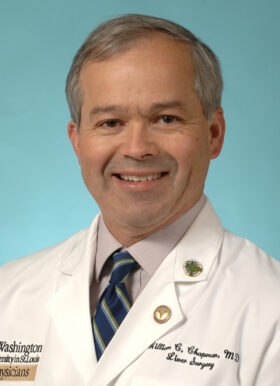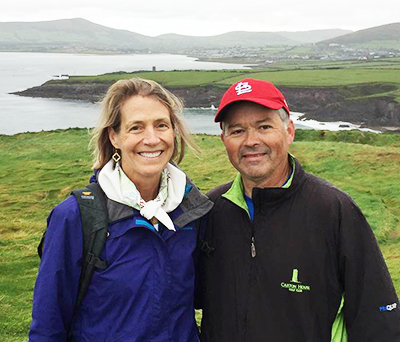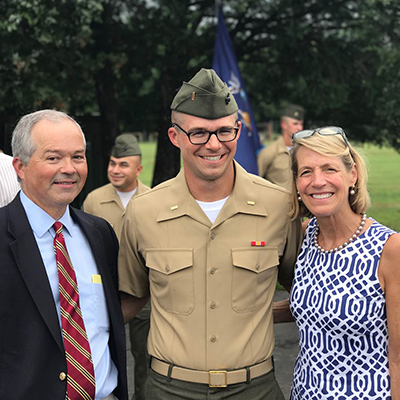William Chapman, MD

William Chapman, MD, is the chief of the section of transplant surgery, chief of division of general surgery and the Eugene M. Bricker professor of Surgery at Washington University School of Medicine.
His areas of specialty include liver transplantation, liver surgery, transplantation surgery, hepatobiliary surgery, pediatric liver transplantation and liver diseases.
Dr. Chapman sees patients at:
- Center for Advanced Medicine, Gastrointestinal Center, 4921 Parkview Place, Suite 12B, St. Louis, MO 63110.
Please call 314-362-2538 or 314-362-7792 to make an appointment.
What happened in the course of schooling to influence you to choose your specialty of transplantation?
I had a circuitous route to choosing this field — and I think that is true for most people, wherever they end up in their career.
I was always interested in surgery. My first involvement in liver-related surgery was with the non-transplant side — liver tumors and biliary tract surgery (liver, gall bladder and bile ducts).
My fellowship was at Kings College in London, the largest transplant center in Europe. During my time there I met some of the transplant surgeons — gaining experience (by necessity) and becoming involved in transplant. When I came back to the United States, my first job was working in a non-transplant role, but after one of the transplant surgeons left, I was asked to join the group. As I got involved, I realized this was what I wanted to do. It was an early mid-career shift with more focus on transplant and that’s where I’ve stayed.

What brought you to Washington University?
Before I came to Washington University, I was a physician at Vanderbilt for 18 years. I trained there and became part of the transplant team — I was pretty sure I would be at Vanderbilt my entire career.
When I was recruited to be the chief of the section of transplantation at Washington University, I wasn’t sure I wanted to leave the team at Vanderbilt. At the time, Washington University was about 10 years ahead of where Vanderbilt was – in terms of transplant. We would use Washington University as the model to run a transplant program.
After my visit here, I saw the opportunity for a leadership role at the very place Vanderbilt was using as an example. It was evident — this was the place for me.
Which aspect of your practice is most interesting?
There are a lot of components in my practice that are very rewarding, so it’s difficult to say there is one particular area. We’ve established a tremendous training program — one of the most sought after programs in the United States. Great candidates from all over the country and the world want to come here. It’s terrific to see surgeons go from little or no experience in transplantation to being able to go out on their own.
Our basic science and clinical research programs are also very interesting. But I’d have to say the most gratifying component is the patients we care for in the field of transplantation. Our patients often are quite debilitated – many are unable to perform normal daily activities, while facing organ failure and risk of death.
After a liver transplant, the majority of our patients are completely restored back to a healthy status. That is the most rewarding aspect of all.
What are the most common types of liver transplants performed here?
We have done and will continue to do live donor liver transplants, but the majority of our patients are transplanted from a cadaveric donor (from a deceased donor). It is great when a live donor comes forward and is willing to donate – but it is a major operation for the donor. If we are able, we try to avoid this and work toward transplantation with a cadaveric donor.
If we have a pediatric patient and it looks like there won’t be a donor available, we will do a living donation – adult to pediatric.
We also have significant experience with a unique procedure called split liver transplants. This involves taking an adult liver and splitting it in two. A smaller part of the liver is given to a pediatric patient and the remaining portion is given to an adult. This approach allows us to get more patients transplanted.
What is the timeline for organ recovery?
There are two types of cadaveric organ donors. The main type (about 90% or more of organ donors) is what we call donation after brain death. In this situation, the person has suffered a catastrophic neurological injury. The most common causes of brain death are trauma, head bleed or anoxic injury (lack of oxygen). If the person has no functional neurological activity and is declared dead, the heart may still continue beating for a few days if he or she is on life support. However, no matter what measures are performed, the heart will soon stop.
Organ recovery usually occurs one to three days after the declaration of brain death. The organ donor team, the organ procurement agency and their nursing team work to optimize and assess organs for transplant.
The second type of cadaveric organ donor is what we call donation after cardiac death. In this situation, a person will have suffered a catastrophic neurological injury, but not be considered brain dead because there is still some brain function. The patient is on life support (ventilator and sometimes blood pressure support medication) and can live for a much longer period of time – as long as life support is continued.
Many families make the decision to withdraw life support in order to allow the patient to expire. The organ recovery team is present, and if the patient expires within a certain period of time (usually an hour) after life support is withdrawn, recovery of the donor organs can begin.
However, if the patient does not expire in that window of time, no organ recovery occurs.

Where do your patients come from for transplant?
We are the leading transplant center in the Midwest, and also the highest volume transplant center in the region. Our patients predominantly come from within a 250 mile radius of St. Louis – but we do have patients who come here from across the country.
In 2017 we were the 4th largest transplant center in the United States – not only a leader in terms of numbers of transplants, but also in results.
We have several unique transplant programs. Under a special protocol, we will consider patients who have more advanced hepatocellular carcinoma, common type of primary liver cancer that’s a usual indication for needing a liver transplant.
For patients who don’t meet the standard recipient listing criteria, we have some alternative strategies. We are able to downstage the patient (using anticancer therapies to control the disease) in order to give them a better chance of receiving a transplant.
We also have a unique protocol for patients with cholangiocarcinoma (cancer of the bile ducts) — a rarer type of cancer involving the liver. We have patients from far-reaching areas of the United States come here for consideration.
In 2017 we performed 131 liver transplants — the norm for us is 110 to 120. We also have very busy transplant programs in kidney, pancreas, heart and lung.
Has the liver transplant procedure changed over the years?
I got involved in transplantation around 1990. Since the 90s there have been changes in the procedure that made it much more streamlined. Technical changes now make it a faster operation that usually lasts 3 to 4 hours, compared to 8 to 10 hours in the early days of the procedure.
The amount of blood transfusion, the need for ventilator support and other support after the surgery – have all dramatically improved. So over time, this has become a much more routine, much better tolerated surgery with less complications and a better survival rate.
What about hepatitis C as a cause for liver transplantation?
In the past, hepatitis C had been the leading indication for needing a liver transplant. This changed with the development of better medication strategies. Today, most patients diagnosed with hepatitis C are able to be treated and cleared of the virus. Many of those patients have improvement or stabilization of their liver dysfunction and don’t require a transplant.
While our treatment of identified hepatitis C has been effective, we still do not have good screening programs for hepatitis C. Most patients don’t know when they contract hepatitis C because the early symptoms are minimal. It is not until the liver disease has progressed and they begin to have symptoms, often 10-20 years after they contracted hepatitis C, that they are diagnosed.
There is another complication for patients who have been treated successfully for hepatitis C. Even though they have been cleared of hepatitis C, these patients may still be at risk for developing cancer (HCC) down the road.
Also, as the need for liver transplants for patients with hepatitis C declines, we are seeing a shift to an increased need for liver transplants in patients with fatty liver disease. This is due to the obesity epidemic and number of patients now living with diabetes. This trend is likely to continue.

Where are you from?
I grew up in North Carolina and spent most of my early life in North Carolina and South Carolina. I went to undergraduate school at the University of North Carolina at Chapel Hill and to medical school at the University of South Carolina at Charleston. I completed my training at Vanderbilt in Nashville, Tennessee and stayed on as faculty there — after my fellowship in London.
But I’ve been here 15 years, so Missouri has become our home.
Which particular award or achievement is most gratifying?
In 2017, I was the recipient of the Francis Moore mentorship award from the American Society of Transplant Surgery. The award acknowledges surgeons for their stewardship of fellowship trainees and junior faculty. This honor has been the most meaningful because former trainees and junior faculty are the ones who nominate you. They know how you look out for your trainees, how you take care of patients and how you handle yourself. You can’t fool your trainees — they know the whole story!
What is the best advice you’ve received?
I take to heart the simple idea of treating people like I would want to be treated – patients, other physicians, trainees and our staff. When I talk to my patients I am honest, optimistic and try to highlight the upside – to make sure they have hope. On the other hand, because we can’t help everyone, I have to be realistic so my patients know the landscape ahead of them and they can make plans for the future.
If you weren’t a doctor, what would you like to be doing?
That’s a tough one because I really like what I do. I have an incredible opportunity here and I certainly don’t think of it as a job. I know I’ll have to retire someday, but I’m not thinking about that right now.